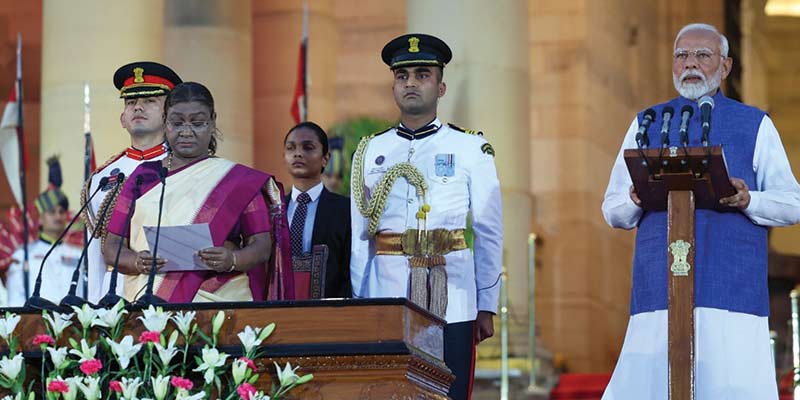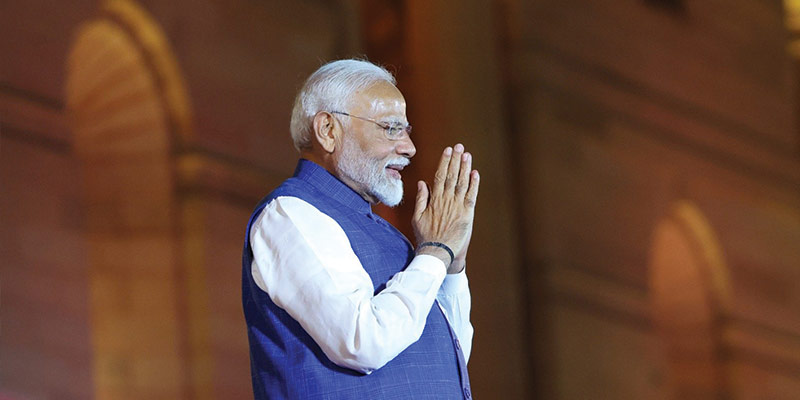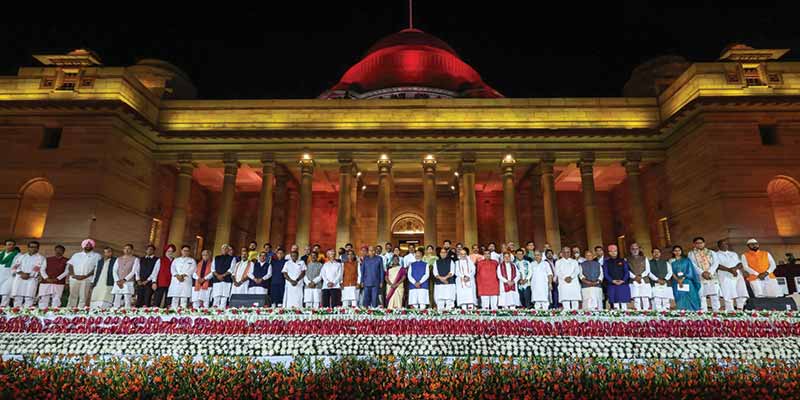- India
- Jun 10
Narendra Modi takes oath for third consecutive term as PM
• Narendra Modi was sworn in as Prime Minister at the Rashtrapati Bhavan in New Delhi on June 9.
• Modi became the first non-Congress leader and second after Jawaharlal Nehru to achieve the feat. Nehru served as Prime Minister for 17 years from 1947 to 1964.
• Modi, 73, first became Prime Minister in 2014 and then returned to office in 2019.
• Modi took the oath for the third straight term, days after the BJP-led National Democratic Alliance (NDA) secured 293 seats out of 543 in the Lok Sabha polls.
‘Neighbourhood First’ policy at PM Modi’s swearing-in
• Top leaders from India’s neighbourhood and the Indian Ocean Region graced the swearing-in ceremony of PM Modi and the Union Council of Ministers.
• Bangladesh Prime Minister Sheikh Hasina, Mauritius Prime Minister Pravind Kumar Jugnauth, his Bhutanese counterpart Tshering Tobgay and Vice-President of Seychelles Ahmed Afif, Maldives President Mohamed Muizzu, Nepal Prime Minister Pushpa Kamal Dahal ‘Prachanda’ and Sri Lankan President Ranil Wickremesinghe attended the ceremony.
• Among the foreign leaders, the decision to invite Muizzu assumed significance as it came against the backdrop of the ties between India and the Maldives witnessing significant strain. It is Muizzu’s first visit to India after he became the island nation’s President on November 17, 2023.
• India has been cooperating with the countries of the Indian Ocean Region under the broader policy framework of Security and Growth for all in the Region (SAGAR).
• The leaders of regional grouping SAARC (South Asian Association for Regional Cooperation) countries attended Modi’s first swearing ceremony when he took the reins as the PM after a massive electoral victory for BJP in 2014.
• Leaders of the BIMSTEC countries attended Modi’s swearing-in ceremony, in 2019 when he became PM for the second consecutive term.
Council of Ministers
• Articles 74 and 75 deal with the Council of Ministers.
• Article 74(1) states that: “There shall be a Council of Ministers with the Prime Minister at the head to aid and advise the President who shall, in the exercise of his functions, act in accordance with such advice.”
• Article 75(1) states that: “The Prime Minister shall be appointed by the President and the other Ministers shall be appointed by the President on the advice of the Prime Minister.”
• The Prime Minister decides who will be the ministers in the Council of Ministers. The Prime Minister allocates ranks and portfolios to the ministers.
• The Council of Ministers comprises ministers who are members of Cabinet, Ministers of State (independent charge), Ministers of State and Deputy Ministers.
• Depending upon the seniority and political importance, the ministers are given the ranks of Cabinet Minister, minister of State and deputy minister.
• Cabinet Ministers hold high-profile portfolios. It is these ministers who constitute the Cabinet, which has been described as “a wheel within a wheel”.
• The total number of ministers, including the Prime Minister, in the Council of Ministers shall not exceed 15 per cent of the total number of members of the Lok Sabha.
• Before a minister enters upon his office, the President shall administer to him the oaths of office and of secrecy according to the forms set out for the purpose in the Third Schedule.
• With a 72-member Council of Ministers taking oath in the third term of the Modi government, it is only nine short of the maximum permissible strength of 81 and six less than the maximum of 78 ministers the Modi government had between 2019 and 2024.
• The maximum strength of the Council of Ministers is 81, including the Prime Ministers, which is 15 per cent of the total strength of 543 in the Lok Sabha.
• The Modi government had touched the maximum strength of 78 in 2021 after expansion, but the outgoing council of ministers had 72 members, including Prime Minister Narendra Modi.
• The Atal Bihari Vajpayee government in 1999 had a total of 74 ministers.
• In May 2009, the Manmohan Singh government had the maximum strength of 79 ministers, including the Prime Minister. During UPA-1 too, the Manmohan Singh-led government touched the maximum strength of 79 ministers.
• As many as 37 ministers have been dropped from the government in Modi’s third term and these include seven with cabinet rank.
• President Murmu administered the Oaths of Office and Secrecy to the 72-member Council of Ministers on June 9.
Cabinet Ministers
1) Rajnath Singh
2) Amit Shah
3) Nitin Gadkari
4) J.P. Nadda
5) Shivraj Singh Chouhan
6) Nirmala Sitharaman
7) Subrahmanyam Jaishankar
8) Manohar Lal Khattar
9) H.D. Kumaraswamy
10) Piyush Goyal
11) Dharmendra Pradhan
12) Jitan Ram Manjhi
13) Rajiv Ranjan Singh alias Lalan Singh
14) Sarbananda Sonowal
15) Dr. Virendra Kumar
16) Kinjarapu Rammohan Naidu
17) Pralhad Joshi
18) Jual Oram
19) Giriraj Singh
20) Ashwini Vaishnaw
21) Jyotiraditya M. Scindia
22) Bhupender Yadav
23) Gajendra Singh Shekhawat
24) Annpurna Devi
25) Kiren Rijiju
26) Hardeep Singh Puri
27) Mansukh Mandaviya
28) G. Kishan Reddy
29) Chirag Paswan
30) C.R. Patil
Ministers of State (Independent Charge)
1) Rao Inderjit Singh
2) Jitendra Singh
3) Arjun Ram Meghwal
4) Jadhav Prataprao Ganpatrao
5) Jayant Chaudhary
Ministers of State
1) Jitin Prasada
2) Shripad Yesso Naik
3) Pankaj Chaudhary
4) Krishan Pal
5) Ramdas Athawale
6) Ram Nath Thakur
7) Nityanand Rai
8) Anupriya Patel
9) V. Somanna
10) Chandra Sekhar Pemmasani
11) S.P. Singh Baghel
12) Sobha Karandlaje
13) Kirtivardhan Singh
14) B.L. Verma
15) Shantanu Thakur
16) Suresh Gopi
17) L. Murugan
18) Ajay Tamta
19) Bandi Sanjay Kumar
20) Kamlesh Paswan
21) Bhagirath Choudhary
22) Satish Chandra Dubey
23) Sanjay Seth
24) Ravneet Singh
25) Durgadas Uikey
26) Raksha Nikhil Khadse
27) Sukanta Majumdar
28) Savitri Thakur
29) Tokhan Sahu
30) Raj Bhushan Choudhary
31) Bhupathi Raju Srinivasa Varma
32) Harsh Malhotra
33) Nimuben Jayantibhai Bambhaniya
34) Murlidhar Mohol
35) George Kurian
36) Pabitra Margherita.
Manorama Yearbook app is now available on Google Play Store and iOS App Store



